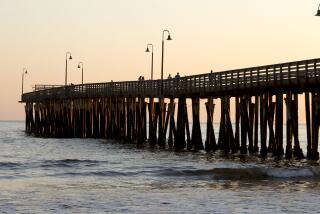Baja’s ‘Nautical Staircase’ Stumbles
SANTA ROSALILLITA, Mexico — Along the desolate Baja California peninsula, President Vicente Fox’s grand plans for a yachters’ paradise have produced only a half-finished marina of crumbling boulders and a highway that ends abruptly, giving way to sand and scrub brush.
The $1.3-billion project, the “Nautical Staircase,” was supposed to build 27 new or revamped marinas along the region’s 1,000 miles of rocky coastline, then add luxury hotels, airports, world-class golf courses, and exclusive ocean-side bistros and spas.
Authorities have yet to complete one step of the staircase, which has been held up by environmental concerns. Many wondered if the project would get off the ground before Fox leaves office in three years.
The president flew to Baja California in 2001 to sell the plan as the “Cancun of the 21st century.” Soon after, construction crews descended on Santa Rosalillita, a collection of faded pastel homes with one paved road, no hotels and no restaurants.
They began work on a marina and a highway running across the peninsula, but construction was suspended because the government tourist agency FONATUR failed to produce an environmental impact study.
In November, the Environmental Department approved the study. But Salvador Nito, FONATUR’s projects manager, said authorities now must commission environmental studies at each of the project’s marina sites -- a painstaking process that had yet to begin. He said his agency hoped that construction would resume this year.
“Things are moving slowly, but we are thinking of the long term,” Nito said. “You don’t build a great development from one day to the next. There’s no reason to hurry.”
That could change. Fox is among the staircase’s biggest supporters, and his administration has earmarked $210 million for the project, the rest coming from private investment. But the president’s term expires in December 2006, and he is legally barred from seeking another.
“We’ve seen this before. A government comes with grand plans for the peninsula until the money runs out and the project dies,” said Patricia Martinez, director of the wetland advocacy group Pro Esteros, in the port city of Ensenada. “Fox only has three years left, and that’s not enough time. This dream of his is impossible.”
In the first phase, FONATUR said it would refurbish five marinas and build 11 before Fox left office in 2006, but even Nito acknowledged that was overly optimistic.
The entire project, initially scheduled for completion in 2016, now could stretch into 2030, he said.
Fox had pushed the idea as a way to develop the coast and create jobs in communities with no electricity, drinking water, telephone service or livelihoods other than subsistence fishing.
Much of the peninsula shuts down at sunset, in part because the only light comes from candles and flashlights. South of Ensenada and north of the modern resort of Los Cabos at the peninsula’s tip, there are only scattered fishing enclaves, surrounded by miles of desert blanketed by towering cardon cacti and cirio trees.
The project’s supporters say that if anyone can tame Baja, it’s FONATUR, which transformed Cancun from a forgotten spit of Caribbean coast into a 25,000-room super resort that attracts 3 million visitors a year. The agency also created sprawling Pacific tourist centers in Ixtapa and Los Cabos.
While Santa Rosalillita waits for work to begin anew, soldiers guard its half-finished marina -- a mass of boulders pieced together with concrete. The open-air construction 410 miles south of the U.S. border is ill-equipped to hold even one yacht.
Still, the marina has already altered the ocean’s currents, triggering erosion, according to a study commissioned by environmental groups.
Marco Antonio Maclish, 27, a fisherman whose family sold FONATUR the land to build the marina, said critics were expecting too much.
“Every great mega-project has its first phase. That rock pier is ours,” he said. “This is the beginning of the second Cancun. You just can’t see it yet.”
Farther down the beach, erosion had stripped away so much sand that Jose Luis Murillo’s wooden home looked ready to topple into the surf.
“The Nautical Staircase was supposed to bring a better life,” Murillo said. “Instead, it’s destroying my home.”
Another phase of the project sits unfinished outside Santa Rosalillita, where crews began building the highway that is supposed to allow yachters to sail to the new marina, then tow their boats east across the peninsula to the Sea of Cortez on the eastern shore.
The highway is meant to wind 20 miles from Santa Rosalillita to MEX 1, the two-lane interstate that runs north-south through Baja California. Instead, it ends after less than three miles, dumping passengers onto a spine-jolting cowpath of stones and potholes.
“We were here two years ago and the highway just ended then too,” said Richard Sobel, a retiree from Vancouver Island who was towing his yacht down the peninsula and decided to see if the new highway had been completed. “Are they ever going to finish this?”
Work hadn’t even begun elsewhere.
About 150 miles up the peninsula from Santa Rosalillita, Cabo Colonet was among several deserted beachheads slated to become posh resorts.
“It’s a good plan, but putting it into effect is another story,” said Kyle Adams-Polzin, 50, a retired electrician and avid surfer from San Diego.
“The people in Mexico City proposing these things have no idea what it’s like out here. It’s much more barren than it looks on a map,” he said.
Cabo Colonet’s only resident, Adams-Polzin lives without electricity, running water or a telephone in a wooden house that he built himself.
“This doesn’t look like a tourist spot to me,” he said, surveying the beach where only pounding surf and chirping crickets could be heard.
“In fact, if they ever did come here to build something, I’d probably move. I like the seclusion.”
More to Read
Sign up for Essential California
The most important California stories and recommendations in your inbox every morning.
You may occasionally receive promotional content from the Los Angeles Times.










